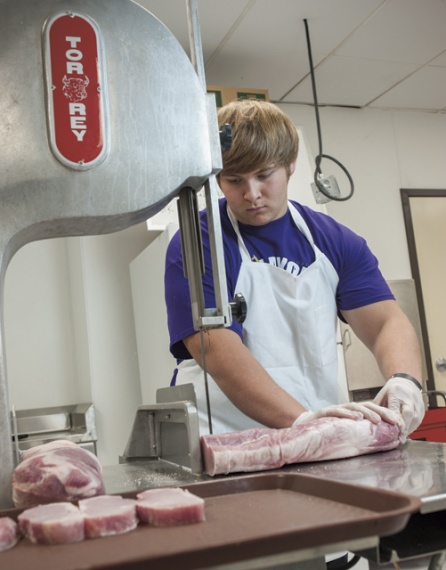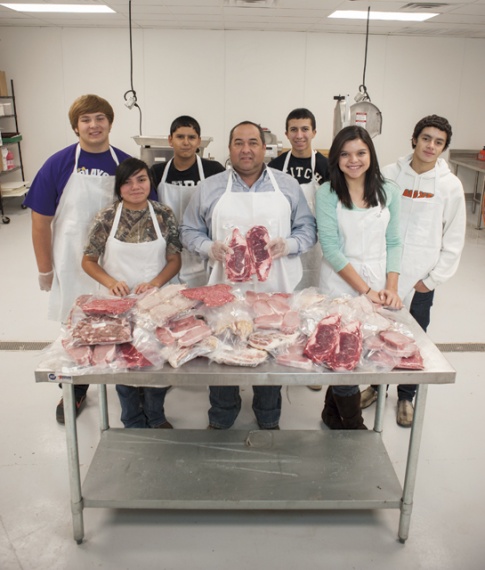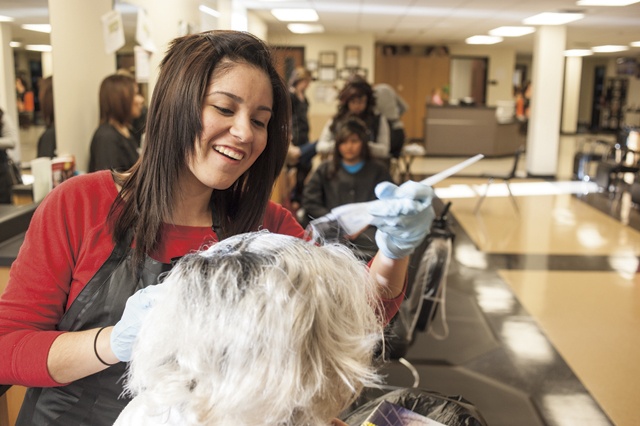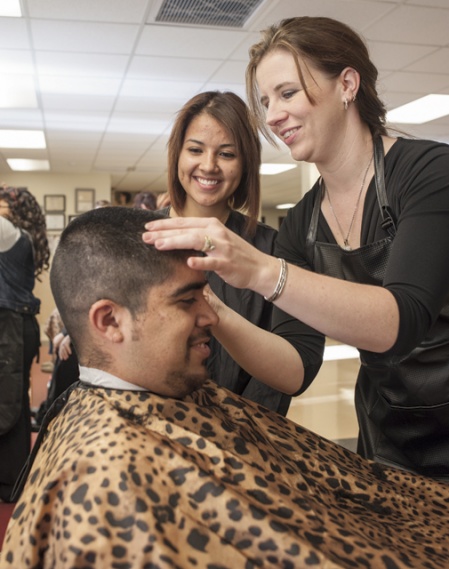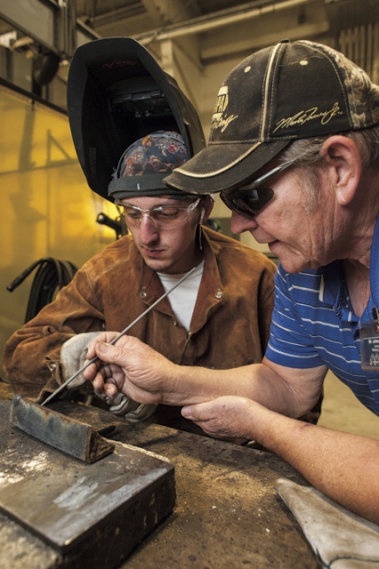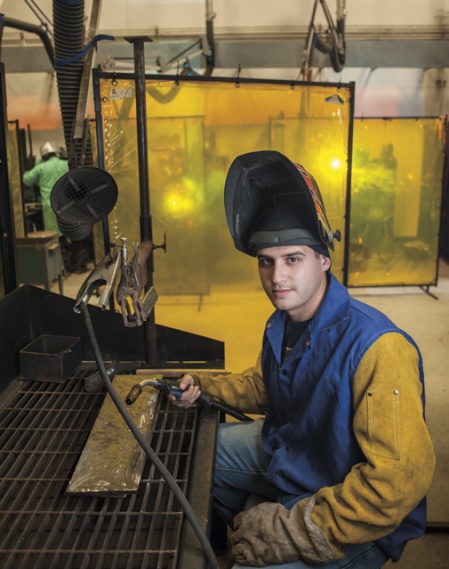Mike Aguilar is in the right role at the right school. As leading man for the one-act play, “The Valiant,” at Sabinal High School—with an enrollment of 144, one of the smallest Class A high schools in Texas—the senior is waxing passionate about the role he plays as a convicted murderer who remains mum on his identity to protect his family.
“I won’t say whether he gets executed or not,” he says, coyly going for the big finish. “You’ll have to see it to find out.”
Passion is good, particularly at Class A schools, where a little bit of student goes a long way. It’s not unusual for a résumé to list several sports, band, Future Farmers of America and any other extracurricular activity that can be shoehorned into a teenager’s breathless schedule.
So when it came to a particular class that popped up on Aguilar’s schedule last year, he was game but maybe a little less enthused. The title on the schedule read “Meat Lab.” One class into the semester, and the slender, dark-haired Aquilar, 18, knew what it wasn’t.
“It wasn’t English III,” he recalls.
A clear indication that Meat Lab isn’t a traditional curriculum, or even hip, social media slang for something more conventional, was the word atop the blackboard—“castration”—and the presence of saws and many sharp knives. Many, many sharp knives.
Definitely not English III, unless the syllabus is heavy with Shakespeare.
In Charlie Black’s classroom, students don’t diagram a sentence; they diagram a side of beef. And prime is a cut of meat, not a number.
Know any English classrooms that have band saws, floor drains, walk-in freezers and grease traps? At Sabinal, which is surrounded by members of Medina Electric Cooperative, they learn English skills disguised as marketing messages for the cuts of beef and pork they slice, process, pack and sell. Math comes in the form of calculating the right percentage blend of fat and lean meat for processing. When the students leave the two-year program, they have a food handling certificate and skills that make them hirable at the local meat market—not to mention that those skills give them instant street cred on the tailgating scene.
This job-training curriculum is part of an approach many high schools across Texas are embracing. As the nation’s economy evolves once again, high schools are seeing a resurgence of vocational programs that teach students trades such as cosmetology, welding, computer technology or any of dozens of others that they can turn into careers or even the edge to work their way through college doing something that pays a little better than pizza delivery.
It’s not English III anymore.
—————
In 1914, as the United States struggled to maintain a workforce that could keep pace with a rapidly industrializing economy, President Woodrow Wilson appointed a commission to study vocational education. It found that more than 12 million Americans were involved in agriculture and 14 million in manufacturing—and yet fewer than 1 percent were adequately trained.
The Smith-Hughes Act, passed by Congress in 1917, was designed to train teachers and support public school programs that taught “agriculture, trades and industry, and home economics.”
From that simple, eight-page bill sprang a revolutionary educational approach that expanded vocational funding from less than $3 million to $176 million over the next three decades.
Texas’ first organized vocational programs were established in 1882 at Prairie View Normal School for Negroes, teaching carpentry and agriculture for boys and, later, home economics for girls. In 1903 the Texas Legislature passed the first vocational education bill to support manual and agricultural training, followed by another that required all rural high schools of more than 300 students to teach agricultural courses.
Though nationally a watershed moment for vocational education, the Smith-Hughes Act initially had a limited effect on Texas, which struggled to meet funding requirements, a shortcoming compounded by the Great Depression. After World War II, Congress liberalized funding requirements and provided for vocational programs in high schools, and Texas caught up.
Texas vocational programs grew steadily and became a valued part of the high school curriculum, withstanding a 1984 assault from the state’s Select Committee on Public Education, which advocated that vocational programs be dropped. SCOPE, behind the passionate leadership of Dallas technology entrepreneur H. Ross Perot, pushed for many recommendations that ultimately became the backbone of sweeping school reform legislation, including more stringent teacher certification, more equitable school financing and “No Pass, No Play” legislation. Vocational education, boosted by popular support, was ultimately spared.
Rapidly changing technology has rendered increasingly obsolete the basics of vocational education funding—agriculture, trades and industry, and home economics—and that required a new vision of career training.
The Central Texas Technology Center is one such approach.
In 2000, the city governments and school district administrations of Seguin and New Braunfels, in cooperation with the local economic development corporations and the Texas Workforce Commission, partnered with Alamo Colleges to find a way to provide more vocational training opportunities for local junior college and high school students.
The high school students take courses utilizing the dual-credit program, which allows up to 30 hours of college level credits while in high school at no cost to the student or the school district. Dual-credit means the students receive both high school and college credit for the same course.
The CTTC opened in 2005, offering high school credit courses determined by a marketing and demographics survey. The start was inauspicious.
“The program had a sluggish start, so the high schools in the area were offered dual credit courses to help boost the overall course enrollments at the center,” says center manager Chester Jenke, touting tech programs such as welding, industrial controls and automation, information tech and building tech.
The idea was to provide training that reflected the industry of the region, which is in Guadalupe Valley EC’s territory, so training would mirror opportunity. The 1,280 students enrolled each semester pursue credits in high-demand fields such as biotechnology, nursing, manufacturing and aerospace technology.
Caterpillar, which has an engine plant in Seguin, sent 1,500 employees to the center last year for training. Each semester, 21 high school students spend about a week touring the Caterpillar facilities for some hands-on learning, Jenke says.
As the program began to place graduates with local employers such as Texas Power Systems, CMC Steel and Caterpillar—as well as in various oil- and gas-related industries in the Eagle Ford Shale development—participation increased, and soon the center’s capacity was taxed to its limits.
“The survey results indicated that the actual market penetration within the local area was about 1 percent, but the center was still rapidly approaching capacity,” Jenke says. “The long-range planning for the future of the center—the partnerships with the local high schools and communities—has begun.”
Jenke says a facility expansion, expected to double the center’s square footage to 50,000, should be in service in 2015. There’s no guarantee it will be enough.
“Is there a void there? Yes,” Jenke says. “A large as the need was five years ago, my vision is that in the next five to six years, it will be even bigger. More students are deciding if they’re a tech student or a credit [college] student. More students are saying they’re not college material, and they need to get a job and support themselves and their families.
“A new buzzword is ‘contemporary college student.’ They may have already started a family, may live at home, and may go to school part time. That’s changing. Education is an evolution mirroring society.”
—————
Some things don’t change. For 35 years, students at La Grange High School and surrounding Fayette EC communities have been putting a new face on vocational education.
That face has foundation, with purple eyeliner and hair latticed into a heart shape using a near-prohibitive amount of aluminum foil. Or it’s got long eyelashes and a more traditional updo with a layered cut. Whatever the face, it’s limited only by the imagination of the 35 girls who are working on their cosmetology certifications under the direction of Catherine Hill.
In Hill’s class, a makeup test involves, you know, makeup. And coming to school with your hair orange, braided and lacquered in the form of a heart can get you an A+, not kicked out of class. (Well, not your hair but the hair of your mannequin.)
“We come up with all kinds of crazy stuff, from nothing,” says Hill. “Toothpicks, toilet paper and Elmer’s Glue. And YouTube is a wonder.”
Yet the program is not about fantasy. It’s about practical reality.
Hill, 33, is an alumna of the program, started in the early 1970s and nurtured for more than three decades by Shirley Norsworthy, who retired in 2004 and now works at Revitalize, a local day spa. From its humble beginnings at the school district’s first vocational tech facility at the old Phillips High School, the school for African-Americans before desegregation, to its current spiffy, 30-chair full-service salon in the old Fayette County Hospital building, Norsworthy gradually built the program into one that gave some students a reason to stay in school.
“Nobody knew about us at first,” says Norsworthy, who earned her cosmetology degree in Austin after her 1971 graduation from LHS, only to return four years later to take over the fledgling program. “We were a lot like the kid from the other side of the tracks. It got to where we would get kids who were trouble in other classes but were no trouble in my class. Some kids stayed in school only because the cosmetology program gave them something to use for their future.”
Hill, the daughter of Ed and Ann Lowes, former band teachers at La Grange, was a successful local cosmetologist when the position to run the program came open again in 2010. She had been uninterested in following her parents into teaching but changed her mind, realizing the time and opportunity were right.
For three hours every day, each of the two classes of juniors and seniors—all girls this year, but they have included boys in the past—learn about more than just makeup and hair styling. They learn the geometry of making cuts, the language of marketing, the science of hair products, the art of design, and the anatomy of the face, skull, hands and feet.
Students come from across the area, including Giddings, Schulenburg, Round Top, Flatonia and even as far as Hallettsville, 45 minutes away, to get an education that can cost up to $20,000 at a private cosmetology school. Support comes mostly from La Grange ISD funding but also from local salons, which provide encouragement and, just as importantly, product. Every Thursday, the classroom turns into a real business with paying customers.
The program’s alumni are everywhere. Norsworthy estimates that 90 percent of the cosmetologists at the five salons in the town of 4,923 are graduates of the program. Some move away to practice and some, including the graduate who used her skills to help pay for her tuition at Texas A&M University as she works toward a veterinary degree, use it to reach other goals.
And then there’s the hidden value of the skill set—it just might be recession-proof. “It doesn’t matter how bad the economy gets,” Hill says. “Every woman has a beauty budget. No matter how bad things get, that’s not going away.”
—————
It’s a busy week back at the Sabinal Meat Lab. The Yellowjackets football team is preparing for the playoffs, the winter sports are gearing up, the state skills competition is approaching and representatives from the H-E-B grocery chain are set to visit to discuss a partnership that would provide training aides and possibly internships to the fledgling meat cutters.
“I feel like I’m running a small business,” says Black, 45, dressed country professional with a western shirt and creased jeans. With the $10,000 in startup money, Black has guided the program into a moneymaking venture that sells to the public every Friday and combines with the school’s culinary arts and floriculture programs to cater events.
That’s a pretty big jump for a program that’s only three years old and was started because the school already had a Future Farmers of America program, a couple of walk-in refrigerator/freezers left over from a cafeteria renovation and a superintendent with a vision to match his name.
Richard Grill—yes, he’s heard ALL the name jokes—grew up on a ranch near Fredericksburg, taught in Burnet and became Sabinal’s superintendent in 2010. He immediately looked for ways to reach more students—and indulge his own interests as a former ag teacher and avid home meat processor.
“We like to say we’re a small school with a big vision,” says the tall, burly 52-year-old with retreating red hair and a moustache. “And we have to be smart with what we do. Sabinal has the seventh-lowest tax rate in the state at 87 cents (per $100 assessment). The state average is $1.27.”
Grill saw the success of Black’s FFA program, which consistently fared as well or better than larger schools in state competitions, and saw he had the right man to spearhead the program.
“Knowing he had a reputation for getting things done, combined with my support, made it a reality,” Grill says. “If we could clone Charlie, like they do with livestock, we could grow, but he has other passions, and we have limitations.”
There was a need. In 2010 there wasn’t a meat market in town, and the closest grocery store was at least 10 miles away. They devised the program as no-kill—they buy full sides of meat from suppliers and occasionally process hunting kills that have been skinned and gutted—that would lead to a food-handler certification. At the end of the first year, the proceeds from sales were paying for the meat and other perishables.
Buoyed by the quick success, the school district funded a renovation of the FFA building in summer 2012, adding floor drains, power washing, washable walls, electricity drop-downs and all the other accoutrements of a full-fledged meat processing facility.
Black’s daughter, Taylor, has represented the school at national FFA conferences and loves it when she mentions what she does.
“When you say you have a meat lab, they say, ‘What? Tell me more about it,’ ” she says.
As with most vocational programs, the curriculum has evolved. Black was born in Del Rio and grew up on a farm in Dublin, where he was active in FFA as a student.
“When I went to school, we were mostly farmers’ and ranchers’ kids,” he says. “Now less than 2 percent go back to the ranch. When we started [FFA] programs, we were focused on things like how to calibrate a crop sprayer. We’ve had to adapt to the clientele, because we’re not training them to be ranchers.”
For many of the students, in fact, the meat lab is a stepping-stone, and the complementary communication skills they learn will help them fulfill their dreams. Aguilar, the actor, plans to study film at the Brooks Institute in California. Joaquin De La Peña aims to major in kinesiology at The University of Texas-San Antonio and become a coach. Taylor Black is headed to Tarleton State University, her dad’s alma mater, with the ultimate goal of a doctorate in agriculture science.
“Not all are going to be meat cutters,” Black says, “but one day they’ll all have to stand up in front of a banker and explain how they will repay a bank loan.”
For now, it’s cutting meat. They’ve got orders—among them 175 rib eyes for Medina County EC and New York strip steaks for the Sabinal School Board appreciation dinner in January. All along the way, they process passion.
“Where there’s a passion,” Grill says, his voice rising and a smile breaking across his face, “you have productivity.”
——————–
Mark Wangrin is an Austin writer.


